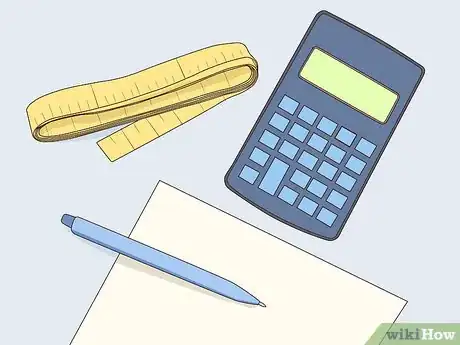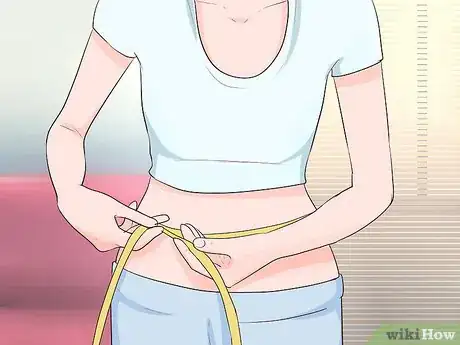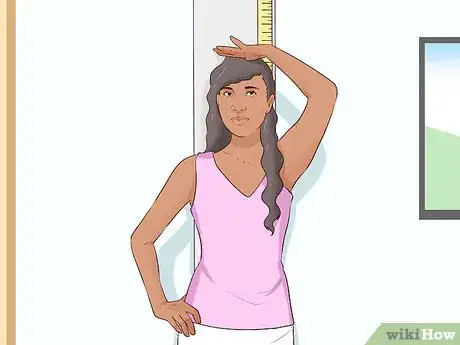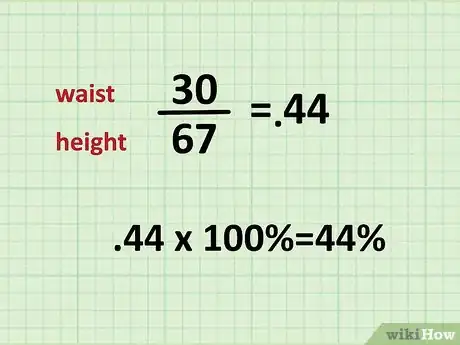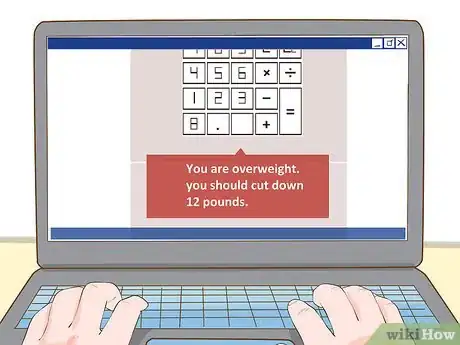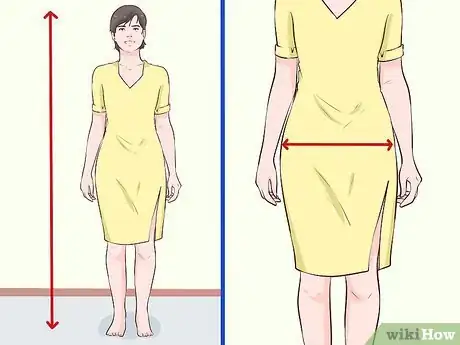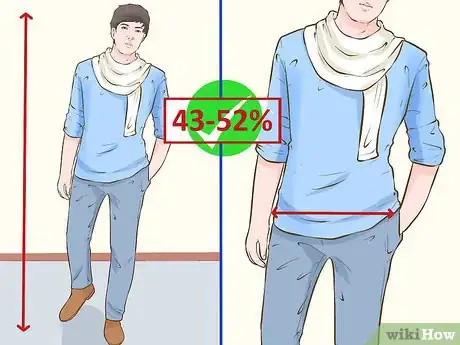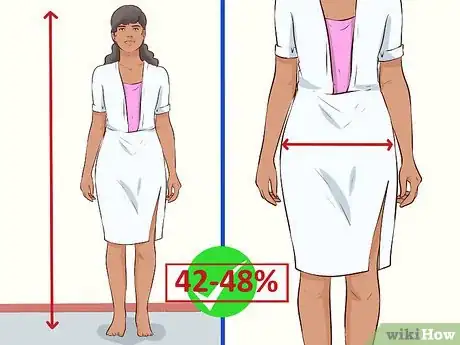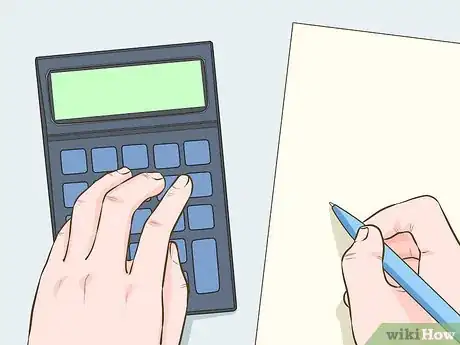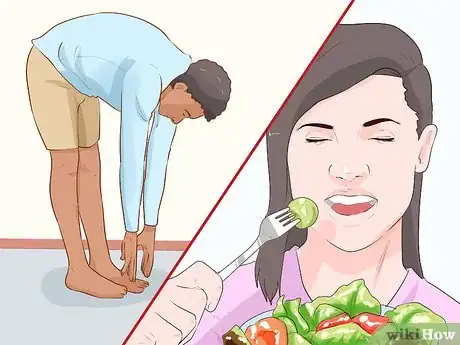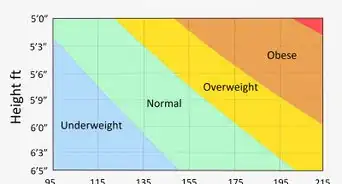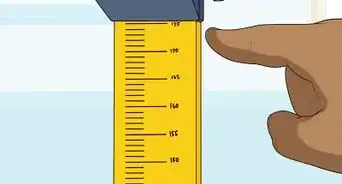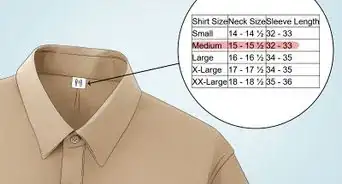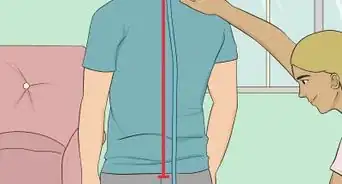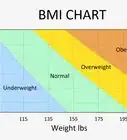This article was co-authored by Michele Dolan. Michele Dolan is a BCRPA certified Personal Trainer in British Columbia. She has been a personal trainer and fitness instructor since 2002.
This article has been viewed 31,462 times.
There are a variety of methods to determine if your current weight, and where you carry that weight, is healthy for you. Your waist-to-height ratio provides information on whether your weight is appropriate for your height and whether or not you're at increased risk for chronic diseases like heart disease.[1] It specifically reflects your distribution of body fat. Many health professionals find your waist-to-height ratio more accurate than BMI (Body Mass Index). Determining your waist-to-height ratio is fairly simple. Once you determine your ratio, you can get a good idea of whether or not you're at a healthy weight.
Steps
Calculating Your Waist-to-Height Ratio by Hand
-
1Get the right supplies ready. You need a few things in order to calculate your waist-to-height ratio. Having everything ready will make this process quick.
- The first thing you'll need is a tape measure. Get a non-elastic, cloth measuring tape. This is the best choice since it won't stretch when you pull it taut around you body.[2]
- Find a calculator or use your smartphone or tablet calculator app. Unless you're really good at doing math in your head, you may want to make sure your calculation is correct.
- Get a pen and paper. Write down your height and waist measurements to keep track of everything.
-
2Measure your waist. Use your measuring tape to get a value for your waist. It's essential to get this measurement as accurate as possible for this equation.
- Start by wrapping the tape measure around your body. Have the end (the one starting with 0) near your belly button in the front.
- Pull the measuring tape so it's about 1 inch above your belly button. This will accurately place the tape measure at your waist and not at hip-level.
- Try to stand next to a mirror so you can see the tape measure around your body. Try to keep it parallel to the floor and at equal level all the way around your body.
- Pull the tape measure so it's snug around your waist, but not digging into your body.
- Also, take this measurement as you breathe out, not as you're inhaling. Your waist is naturally at its relaxed state as you exhale. Record this number on your sheet of paper.
Advertisement -
3Measure your height. Just like with your waist circumference measurement, you want to make sure that your height is accurate as well. Use your known height or ask someone to measure your height.
- If you don't have anyone to measure your height, use the last height that was taken from a doctor's visit. Unless you're a child, your height has probably remained the same since your last doctor's visit.
- If you have someone to help take your height, you can get a more updated measurement.
- To start, make sure you're not wearing shoes or socks. You don't want to artificially increase your height by having your shoes on. This will not be an accurate reflection of your true height.
- Stand with your back and heels pressed up against a wall — make sure you are on a flat, non-carpeted surface. Using a ruler, have your friend or family member press the ruler to the top of your head, so it's completely parallel to the floor. Using a pencil, make a small mark on the wall at your height level.
- Using the measuring tape, measure from the floor up to the mark. This is how tall you are.
-
4Input your waist and height measurements into the equation. After you have both your height and your waist, you can input your measurements into a simple equation to determine your waist-to-height ratio.
- The equation to determine this ratio is: waist in inches divided by height in inches.
- For example, if your waist is 30" and your height is 67", your equation would look like: 30" / 67" = .44. This is your waist-to-height ratio.
Determining Your Waist-to-Height Ratio Online
-
1Find an appropriate online source. If math isn't your strong point or you don't have a calculator on hand, you can also figure out your waist-to-height ratio by using free, online calculators.
- There are many websites that offer to do your waist-to-height ratio. However, not all websites are preferred sources and may give you incorrect or unsubstantiated information.
- Try to use sources that are unbiased and well-founded. These will not only give you an accurate measurement, but also provide you with accurate information.
- Sources you can try include:
- Penn State Pro Wellness: http://prowellness.vmhost.psu.edu/prevention/understanding_risk/whtr
- Health & Fitness Calculators: http://www.health-calc.com/body-composition/waist-to-height-ratio
-
2Input your information. The online calculators are really easy and simple to use. Plus, they allow you to figure out your waist-to-height ratio just in a few clicks.
- Measure your waist and height. You will need to measure your waist and height to input this information into the online calculator. Be accurate so the ratio comes out correctly.
- Online calculators will also generally require that you input your gender — male or female. This doesn't factor into the actual calculation, but does impact how your results are read.
-
3Take recommendations with a grain of salt. Many of the online websites will not only provide you with your waist-to-height ratio, but also provide you with information, advice or suggestions for managing your weight.
- After you've put in your information and received your waist-to-height ratio, you may get some information regarding your results. Many sites will provide recommendations based on these results.
- Since your waist-to-height ratio reflects your risk for chronic health conditions and provides information regarding your body fat distribution, if your ratio is high, a website may suggest losing weight.
- The same goes for a lower waist-to-height ratio. If you have an overly low ratio, a website may advise that you are underweight and should gain weight in order to be healthy.
- Although in general, these recommendations may be appropriate, do not gain or lose weight without speaking to your doctor first. Remember, this information is only part of your health picture and should not be used to diagnose or treat any condition.
Understanding the Significance of Your Ratio
-
1Understand the implications of a high or low waist-to-height ratio. After either calculating your waist-to-height ratio by hand or using an online calculator, see how your results measure up. You can use this information to direct you on a path towards better health.
- Waist-to-height ratio cannot necessarily tell you that you are overweight or underweight or even give you a specific amount of weight to lose. However, it does give you information about how much excess fat you have around your mid-section.
- Increased levels of abdominal fat, especially visceral fat (the kind found in and around your abdominal organs) can be dangerous and increases your risk for diabetes, heart disease and breast cancer.[3]
-
2Interpret your ratio if you are a man. Waist-to-height ratios will differ between men and women. Since men typically have more muscle mass and store excess fat in different locations, interpreting your ratio correctly is essential.
- For men, if your waist-to-height ratio is over .53, you're more than likely overweight. If it's over .63, you may even be obese. With ratio levels this high, you may benefit from weight loss.[4]
- If your waist-to-height ratio is .43 – .52 as a man, you're most likely at a normal weight and do not have increased levels of visceral fat. However, if your ratio is below .43 it may suggest that you're too thin and underweight.
-
3Decipher your ratio if you are a woman. Although very similar to the guidelines for men, women have more wiggle room when it comes to their waist-to-height ratio.
- For women, it's very similar. If your waist-to-height ratio is above .49 you're more than likely overweight and if it's over .58 you could even be obese.
- A normal waist-to-height ratio for women is between .42 – .48. If it's less than .42 you may be too thin and considered underweight.
-
4Calculate other weight calculations. Your waist-to-height ratio is just one measure of your overall health. Alone, it will not give you a clear picture of whether you're over or underweight or whether or not you would benefit from a change to your weight.
- Whenever you're trying to determine whether or not you should lose or gain weight, it's best to find out a variety of weight measurements — not just one. The more measurements you have, the more clear of a picture you'll get.
- Consider your ideal body weight. This is done by a calculation that uses your gender and height to find an appropriate weight for you. If your weight is above or below this value, you may benefit from weight gain or loss.[5]
- BMI is another measure that could indicate whether or not you're overweight. Similar to waist-to-height ratio, BMI shows how much body fat you have in relation to lean mass.[6] The higher the BMI, the more likely it is that you're overweight or obese.
- Check your waist-to-hip ratio. This is similar to the waist-to-height ratio and can provide you with similar information about visceral fat. This ratio is determined by the following calculation: waist measurement divided by hip measurement.
- Waist circumference is something you should already have from doing your waist-to-height ratio. This is the measurement around your midsection. If your waist circumference is high (over 35 inches for women or 40 inches for men), it suggests that you are carrying a lot of excess weight that could be visceral fat.
-
5Talk to your doctor. Now that you have your actual waist-to-height ratio and also have information regarding your current weight, BMI and waist circumference, you can bring this information to a meeting with your doctor.
- If you've figured out a variety of weight measures and are noticing that many are indicating that you're overweight or obese, it's a smart idea to bring this information to your doctor.
- Being overweight or obese, especially if you're carrying that extra weight around your midsection, increases your risk for a variety of chronic and dangerous health conditions like diabetes or high blood pressure.[7]
- If many of the weight measurements are saying you're underweight or too thin, consider talking to your doctor about possible weight gain and if you'd benefit from weighing a little more.
- Regardless of what your weight measurements indicate, always talk to your doctor before diagnosing yourself with a certain condition or making any large changes to your weight.
-
6Consider weight loss or weight gain. If you've talked to your doctor and have concluded that your weight should change based on the information you've gathered, consider changing your diet and lifestyle to push your weight in the right direction.
- If your BMI, waist circumference and waist-to-height ratio all indicate you're overweight and your doctor agrees, consider losing weight.
- You'll most likely need to follow a lower calorie diet and increase your exercise to help you get down to a healthier weight.
- If your BMI, ideal body weight and waist-to-height ratio indicate that you're a normal or healthy weight, make sure you try to keep your weight stable to help prevent any future issues. Regular weigh-ins can help keep you aware of any small and unwanted weight fluctuations.
- If these indicators show that you're underweight and your doctor thinks you'd benefit from weight gain, consider modifying your diet to include a few extra calories to help you slowly increase your weight.
References
- ↑ http://prowellness.vmhost.psu.edu/prevention/understanding_risk/whtr
- ↑ http://www.health-calc.com/body-composition/waist-to-height-ratio
- ↑ http://www.health.harvard.edu/staying-healthy/abdominal-fat-and-what-to-do-about-it
- ↑ http://prowellness.vmhost.psu.edu/prevention/understanding_risk/whtr
- ↑ http://www.medicalnewstoday.com/info/obesity/how-much-should-i-weigh.php
- ↑ http://www.nhlbi.nih.gov/health/educational/lose_wt/BMI/bmicalc.htm
- ↑ http://www.health.harvard.edu/staying-healthy/abdominal-fat-and-what-to-do-about-it
